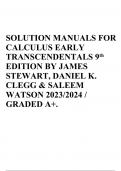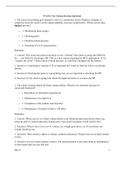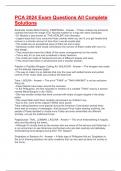SOLUTION MANUALS FOR CALCULUS EARLY TRANSCENDENTALS 9th EDITION BY JAMES STEWART, DANIEL K. CLEGG & SALEEM WATSON 2023/2024 / GRADED A+. 1FUNCTIONS AND MODELS
1.1Four Ways to Represent a Function
1.The functions() = +√2 − and() = +√2 − give exactly the same output values for every input value, so
andare equal.
2.() =2−
− 1=( − 1)
− 1= for − 1 6= 0, soand[where() = ] are not equal because (1)is undefined and
(1) = 1.
3.(a) The point(−2 2)lies on the graph of, so(−2) = 2. Similarly, (0) = −2, (2) = 1, and (3) 25.
(b) Only the point(−4 3)on the graph has a value of3, so the only value offor which() = 3is−4.
(c) The function outputs()are never greater than 3, so () ≤ 3for the entire domain of the function. Thus, () ≤ 3for
−4 ≤ ≤ 4(or, equivalently, on the interval [−4 4]).
(d) The domain consists of all values on the graph of:{ | −4 ≤ ≤ 4} = [−4 4]. The range ofconsists of all the
values on the graph of:{ | −2 ≤ ≤ 3} = [−2 3].
(e) For any1
2in the interval[0 2], we have(1) (2). [The graph rises from(0 −2)to(2 1).] Thus,()is
increasing on[0 2].
4.(a) From the graph, we have (−4) = −2and(3) = 4.
(b) Since(−3) = −1and(−3) = 2, or by observing that the graph of is above the graph ofat = −3,(−3)is larger
than(−3).
(c) The graphs ofandintersect at = −2and = 2, so () = ()at these two values of.
(d) The graph oflies below or on the graph of for−4 ≤ ≤ −2and for2 ≤ ≤ 3. Thus, the intervals on which
() ≤ ()are[−4 −2]and[2 3].
(e) () = −1is equivalent to = −1, and the points on the graph of with values of−1are(−3 −1)and(4 −1), so
the solution of the equation () = −1is = −3or = 4.
(f) For any1 2in the interval[−4 0], we have(1)
(2). Thus,()is decreasing on[−4 0].
(g) The domain ofis{ | −4 ≤ ≤ 4} = [−4 4]. The range ofis{ | −2 ≤ ≤ 3} = [−2 3].
(h) The domain ofis{ | −4 ≤ ≤ 3} = [−4 3]. Estimating the lowest point of the graph of as having coordinates
(0 05), the range ofis approximately{ | 05 ≤ ≤ 4} = [05 4].
5.From Figure 1 in the text, the lowest point occurs at about ( ) = (12 −85). The highest point occurs at about (17 115).
Thus, the range of the vertical ground acceleration is −85 ≤ ≤ 115. Written in interval notation, the range is [−85 115].
c°2021 Cengage Learning. All Rights Reserved. May not be scanned, copied, or duplicated, or posted to a publicly accessible website, in whole or in part. 9 10¤CHAPTER 1FUNCTIONS AND MODELS
6.Example 1: A car is driven at60mih for2hours. The distance
traveled by the car is a function of the time . The domain of the
function is{ | 0 ≤ ≤ 2}, whereis measured in hours. The range
of the function is{ | 0 ≤ ≤ 120}, whereis measured in miles.
Example 2: At a certain university, the number of students on
campus at any time on a particular day is a function of the time after
midnight. The domain of the function is { | 0 ≤ ≤ 24}, whereis
measured in hours. The range of the function is { | 0 ≤ ≤ },
whereis an integer andis the largest number of students on
campus at once.
Example 3: A certain employee is paid $800per hour and works a
maximum of30hours per week. The number of hours worked is
rounded down to the nearest quarter of an hour. This employee’s
gross weekly payis a function of the number of hours worked .
The domain of the function is [0 30]and the range of the function is
{0 200 400 23800 24000}.240pay
hours 0.250.500.75029.50 29.753024238236
7.We solve3 − 5 = 7for:3 − 5 = 7⇔ −5 = −3 + 7⇔ =35 −75. Since the equation determines exactly
one value offor each value of, the equation definesas a function of.
8.We solve32− 2 = 5for:32− 2 = 5⇔ −2 = −32+ 5⇔ =322−52. Since the equation determines
exactly one value offor each value of, the equation definesas a function of.
9.We solve2+ ( − 3)2= 5for:2+ ( − 3)2= 5⇔ ( − 3)2= 5 − 2⇔ − 3 = ±√5 − 2⇔
= 3 ±√5 − 2. Some input valuescorrespond to more than one output . (For instance, = 1corresponds to = 1and
to = 5.) Thus, the equation does not defineas a function of.
10.We solve2 + 52= 4for:2 + 52= 4⇔ 52+ (2) − 4 = 0⇔
=−2 ±
(2)2− 4(5)(−4)
2(5)=−2 ±√42+ 80
10=− ±√2+ 20
5(using the quadratic formula). Some input
valuescorrespond to more than one output . (For instance, = 4corresponds to = −2and to = 25.) Thus, the
equation does not defineas a function of.
11.We solve( + 3)3+ 1 = 2for:( + 3)3+ 1 = 2⇔ ( + 3)3= 2 − 1⇔ + 3 =3√2 − 1⇔
= −3 +3√2 − 1. Since the equation determines exactly one value of for each value of, the equation definesas a
function of.
c°2021 Cengage Learning. All Rights Reserved. May not be scanned, copied, or duplicated, or posted to a publicly accessible website, in whole or in part. SECTION 1.1FOUR WAYS TO REPRESENT A FUNCTION ¤11
12.We solve2 − || = 0for:2 − || = 0⇔ || = 2⇔ = ±2. Some input valuescorrespond to more than
one output. (For instance, = 1corresponds to = −2and to = 2.) Thus, the equation does not defineas a function
of.
13.The height 60 in( = 60)corresponds to shoe sizes 7 and 8 ( = 7and = 8). Since an input valuecorresponds to more
than output value, the table does not defineas a function of.
14.Each yearcorresponds to exactly one tuition cost . Thus, the table definesas a function of.
15.No, the curve is not the graph of a function because a vertical line intersects the curve more than once. Hence, the curve fails
the Vertical Line Test.
16.Yes, the curve is the graph of a function because it passes the Vertical Line Test. The domain is [−2 2]and the range
is[−1 2].
17.Yes, the curve is the graph of a function because it passes the Vertical Line Test. The domain is [−3 2]and the range
is[−3 −2) ∪ [−1 3].
18.No, the curve is not the graph of a function since for = 0,±1, and±2, there are infinitely many points on the curve.
19.(a) When = 1950, ≈ 138◦C, so the global average temperature in 1950 was about 138◦C.
(b) When = 142◦C, ≈ 1990.
(c) The global average temperature was smallest in 1910 (the year corresponding to the lowest point on the graph) and largest
in 2000 (the year corresponding to the highest point on the graph).
(d) When = 1910, ≈ 135◦C, and when = 2000, ≈ 144◦C. Thus, the range ofis about[135,144].
20.(a) The ring width varies from near 0 mmto about16 mm, so the range of the ring width function is approximately [0 16].
(b) According to the graph, the earth gradually cooled from 1550 to 1700, warmed into the late 1700s, cooled again into the
late 1800s, and has been steadily warming since then. In the mid 19th century, there was variation that could have been
associated with volcanic eruptions.
21.The water will cool down almost to freezing as the ice melts. Then, when
the ice has melted, the water will slowly warm up to room temperature.
22.The temperature of the pie would increase rapidly, level off to oven
temperature, decrease rapidly, and then level off to room temperature.
c°2021 Cengage Learning. All Rights Reserved. May not be scanned, copied, or duplicated, or posted to a publicly accessible website, in whole or in part.






